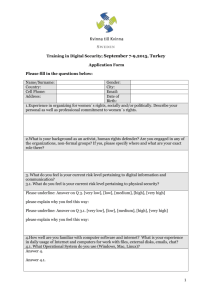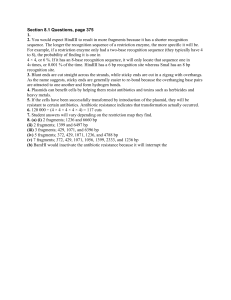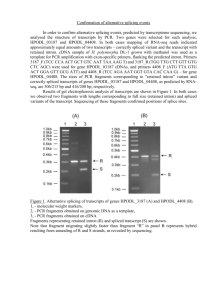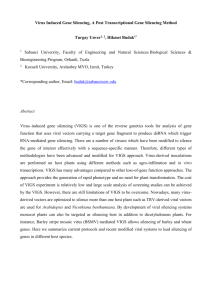tpj12457-sup-0003-MethodsS1
advertisement
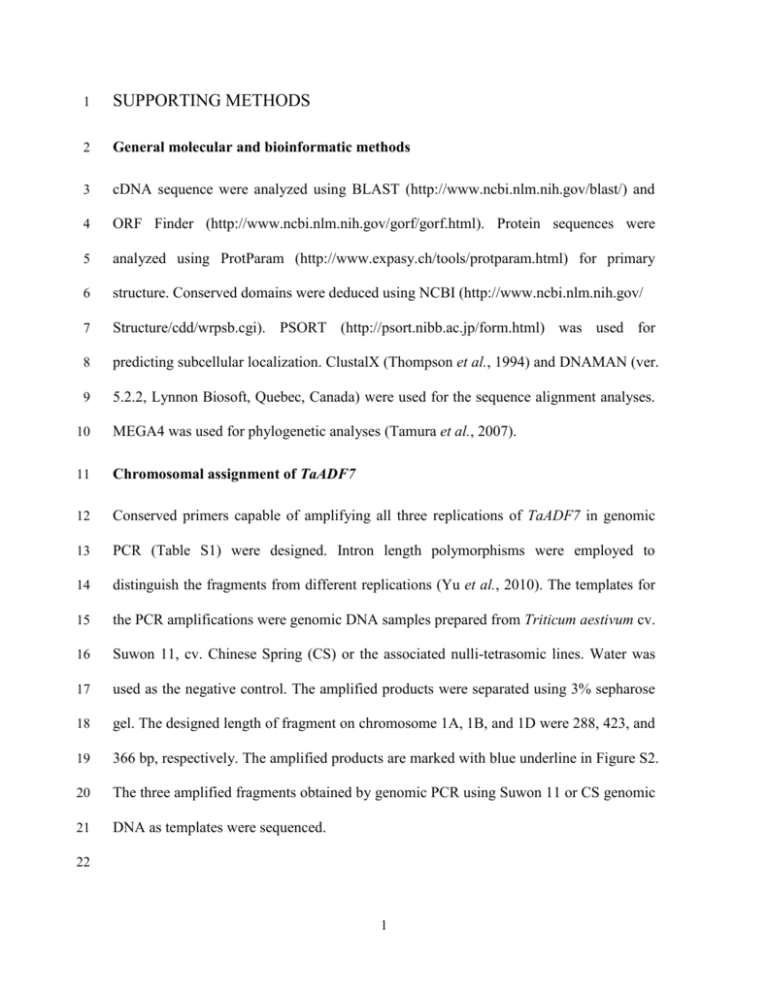
1 SUPPORTING METHODS 2 General molecular and bioinformatic methods 3 cDNA sequence were analyzed using BLAST (http://www.ncbi.nlm.nih.gov/blast/) and 4 ORF Finder (http://www.ncbi.nlm.nih.gov/gorf/gorf.html). Protein sequences were 5 analyzed using ProtParam (http://www.expasy.ch/tools/protparam.html) for primary 6 structure. Conserved domains were deduced using NCBI (http://www.ncbi.nlm.nih.gov/ 7 Structure/cdd/wrpsb.cgi). PSORT (http://psort.nibb.ac.jp/form.html) was used for 8 predicting subcellular localization. ClustalX (Thompson et al., 1994) and DNAMAN (ver. 9 5.2.2, Lynnon Biosoft, Quebec, Canada) were used for the sequence alignment analyses. 10 MEGA4 was used for phylogenetic analyses (Tamura et al., 2007). 11 Chromosomal assignment of TaADF7 12 Conserved primers capable of amplifying all three replications of TaADF7 in genomic 13 PCR (Table S1) were designed. Intron length polymorphisms were employed to 14 distinguish the fragments from different replications (Yu et al., 2010). The templates for 15 the PCR amplifications were genomic DNA samples prepared from Triticum aestivum cv. 16 Suwon 11, cv. Chinese Spring (CS) or the associated nulli-tetrasomic lines. Water was 17 used as the negative control. The amplified products were separated using 3% sepharose 18 gel. The designed length of fragment on chromosome 1A, 1B, and 1D were 288, 423, and 19 366 bp, respectively. The amplified products are marked with blue underline in Figure S2. 20 The three amplified fragments obtained by genomic PCR using Suwon 11 or CS genomic 21 DNA as templates were sequenced. 22 1 23 Supplementary details for VIGS 24 Selection of silencing fragments and detection of silencing efficiency 25 The first silenced fragment (303 bp) was located at the 3'-UTR (Figure S2, blue underline) 26 and the second (177 bp) was located at the partial open reading frame and the 5'-UTR 27 (Figure S2, black underline). The two fragments did not show any similarity with any 28 other wheat gene in BLAST analyses (http://blast.ncbi.nlm.nih.gov/Blast/). Three copies 29 shared 94.46% and 89.83% nucleotide identity with each other for two VIGS fragments, 30 respectively. A pair of primers located at 5'-UTR (Figure S2, red underline) was designed 31 to test the silencing efficiency of the first silenced fragment for every copy, and another 32 pair of primers located at 3'-UTR (Figure S2, green underline) was designed to test the 33 silencing efficiency of the second silenced fragment for every copy. The productions of 34 six pair of primers (Table S1) were sequenced to assure the specificity of production. 35 Virus inoculation 36 The two fragments were used to replace the TaPDS (wheat phytoene desaturase) coding 37 sequence in BSMV:TaPDS. Recombinant plasmids were linearized. Capped in vitro 38 transcripts were produced from linearized plasmids with RiboMAX Large Scale RNA 39 Production System-T7 (Promega, Madison, WI, USA). Transcripts of each of the BSMV 40 genomes (wild type or genetically modified) were mixed in a 1:1:1 ratio. A 7.5- ml 41 aliquot of the transcription mix was combined with 45 μl of 1× Fes buffer (Pogue et al., 42 1998) and directly applied (Holzberg et al., 2002). Four BSMV viruses (BSMV:γ, 43 BSMV:TaPDS, BSMV:TaADF7-1 and BSMV:TaADF7-2) were individually inoculated 44 on the second leaf of two-leaf wheat seedlings by gently rubbing the leaves with gloved 2 45 fingers (Hein et al., 2005). After they were stored for 24 h in the dark, the seedlings were 46 placed in a growth chamber at 25 °C and examined for symptoms. 47 Control design and reproducibility of the data for VIGS 48 To confirm the VIGS system functioned correctly, BSMV:TaPDS was used as a negative 49 control to induce photo-bleaching on inoculated plants (Holzberg et al., 2002). Control 50 plants were treated with 1× Fes buffer to replace virus. Expression level of TaADF2, 51 another wheat ADF gene that shares 49.35% nucleotide identity with TaADF7, was tested 52 as the systems control. At least three plants from different pots were treated as one 53 sample, and each time point has three samples. Wheat elongation factor TaEF-1a was 54 used as internal reference for qRT-PCR analysis. The whole experiment was repeated 55 three times. One-way analysis of variance was performed by the SPSS software program 56 (ver. 16.0, SPSS Inc., Chicago, IL, U.S.A.). 57 Accession numbers 58 The nucleotide sequences used in this study had the following GenBank accession 59 numbers: TaADF7 (JX486723), OsADF7 (Q0DLA3), BdADF7 (XP_003569002), TaEF- 60 1a (Q03033), AtFim1 (NM_118804), Rattus norvegicus BAX (U32098), TaPDS 61 (FJ517553) TaPR1 (AAK60565), TaPR2 (DQ090946), TaPR5 (FG618781), TaSOD 62 (CB307850), TaCAT (X94352), and TaNOX (AY561153). 63 References 64 65 66 67 68 69 Hein, I., Barciszewska-Pacak, M., Hrubikova, K., Williamson, S., Dinesen, M., Soenderby, I.E., Sundar, S., Jarmolowski, A., Shirasu, K. and Lacomme, C. (2005) Virus–induced gene silencing-based functional characterization of genes associated with powdery mildew resistance in barley. Plant Physiol., 138, 2155-2164. Holzberg, S., Brosio, P., Gross, C. and Pogue, G.P. (2002) Barley stripe mosaic virus‐induced gene silencing in a monocot plant. Plant J., 30, 315-327. 3 70 71 72 73 74 75 76 77 78 79 80 81 82 83 84 85 86 Pogue, G., Lindbo, J., Dawson, W. and Turpen, T. (1998) Tobamovirus transient expression vectors: tools for plant biology and high-level expression of foreign proteins in plants. In Plant Molecular Biology Manual (Gelvin, S.B. and Schilperoort, R.A. eds). Berlin: Springer, pp. 63-97. Tamura, K., Dudley, J., Nei, M. and Kumar, S. (2007) MEGA4: molecular evolutionary genetics analysis (MEGA) software version 4.0. Mol. Biol. Evol., 24, 1596-1599. Thompson, J.D., Higgins, D.G. and Gibson, T.J. (1994) CLUSTAL W: improving the sensitivity of progressive multiple sequence alignment through sequence weighting, position-specific gap penalties and weight matrix choice. Nucleic Acids Res., 22, 4673-4680. Tolvanen, M.E., Ortutay, C., Barker, H.R., Aspatwar, A., Patrikainen, M. and Parkkila, S. (2013) Analysis of evolution of carbonic anhydrases IV and XV reveals a rich history of gene duplications and a new group of isozymes. Biorg. Med. Chem., 21, 1303-1310. Yu, C., Li, Y., Li, B., Liu, X., Hao, L., Chen, J., Qian, W., Li, S., Wang, G. and Bai, S. (2010) Molecular analysis of phosphomannomutase (PMM) genes reveals a unique PMM duplication event in diverse Triticeae species and the main PMM isozymes in bread wheat tissues. BMC Plant Biol., 10, 214. 4





